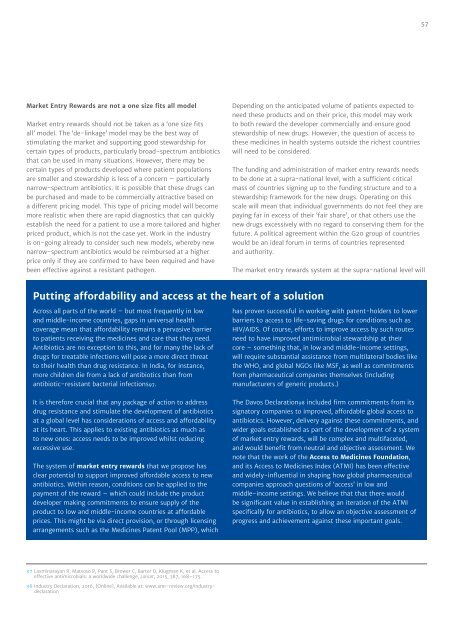TACKLING DRUG-RESISTANT INFECTIONS GLOBALLY FINAL REPORT AND RECOMMENDATIONS
qQvJ300ETXu
qQvJ300ETXu
You also want an ePaper? Increase the reach of your titles
YUMPU automatically turns print PDFs into web optimized ePapers that Google loves.
57<br />
Market Entry Rewards are not a one size fits all model<br />
Market entry rewards should not be taken as a ‘one size fits<br />
all’ model. The ‘de-linkage’ model may be the best way of<br />
stimulating the market and supporting good stewardship for<br />
certain types of products, particularly broad-spectrum antibiotics<br />
that can be used in many situations. However, there may be<br />
certain types of products developed where patient populations<br />
are smaller and stewardship is less of a concern – particularly<br />
narrow-spectrum antibiotics. It is possible that these drugs can<br />
be purchased and made to be commercially attractive based on<br />
a different pricing model. This type of pricing model will become<br />
more realistic when there are rapid diagnostics that can quickly<br />
establish the need for a patient to use a more tailored and higher<br />
priced product, which is not the case yet. Work in the industry<br />
is on-going already to consider such new models, whereby new<br />
narrow-spectrum antibiotics would be reimbursed at a higher<br />
price only if they are confirmed to have been required and have<br />
been effective against a resistant pathogen.<br />
Depending on the anticipated volume of patients expected to<br />
need these products and on their price, this model may work<br />
to both reward the developer commercially and ensure good<br />
stewardship of new drugs. However, the question of access to<br />
these medicines in health systems outside the richest countries<br />
will need to be considered.<br />
The funding and administration of market entry rewards needs<br />
to be done at a supra-national level, with a sufficient critical<br />
mass of countries signing up to the funding structure and to a<br />
stewardship framework for the new drugs. Operating on this<br />
scale will mean that individual governments do not feel they are<br />
paying far in excess of their ‘fair share’, or that others use the<br />
new drugs excessively with no regard to conserving them for the<br />
future. A political agreement within the G20 group of countries<br />
would be an ideal forum in terms of countries represented<br />
and authority.<br />
The market entry rewards system at the supra-national level will<br />
Putting affordability and access at the heart of a solution<br />
Across all parts of the world – but most frequently in low<br />
and middle-income countries, gaps in universal health<br />
coverage mean that affordability remains a pervasive barrier<br />
to patients receiving the medicines and care that they need.<br />
Antibiotics are no exception to this, and for many the lack of<br />
drugs for treatable infections will pose a more direct threat<br />
to their health than drug resistance. In India, for instance,<br />
more children die from a lack of antibiotics than from<br />
antibiotic‐resistant bacterial infections97.<br />
has proven successful in working with patent-holders to lower<br />
barriers to access to life-saving drugs for conditions such as<br />
HIV/AIDS. Of course, efforts to improve access by such routes<br />
need to have improved antimicrobial stewardship at their<br />
core – something that, in low and middle-income settings,<br />
will require substantial assistance from multilateral bodies like<br />
the WHO, and global NGOs like MSF, as well as commitments<br />
from pharmaceutical companies themselves (including<br />
manufacturers of generic products.)<br />
It is therefore crucial that any package of action to address<br />
drug resistance and stimulate the development of antibiotics<br />
at a global level has considerations of access and affordability<br />
at its heart. This applies to existing antibiotics as much as<br />
to new ones: access needs to be improved whilst reducing<br />
excessive use.<br />
The system of market entry rewards that we propose has<br />
clear potential to support improved affordable access to new<br />
antibiotics. Within reason, conditions can be applied to the<br />
payment of the reward – which could include the product<br />
developer making commitments to ensure supply of the<br />
product to low and middle-income countries at affordable<br />
prices. This might be via direct provision, or through licensing<br />
arrangements such as the Medicines Patent Pool (MPP), which<br />
The Davos Declaration98 included firm commitments from its<br />
signatory companies to improved, affordable global access to<br />
antibiotics. However, delivery against these commitments, and<br />
wider goals established as part of the development of a system<br />
of market entry rewards, will be complex and multifaceted,<br />
and would benefit from neutral and objective assessment. We<br />
note that the work of the Access to Medicines Foundation,<br />
and its Access to Medicines Index (ATMI) has been effective<br />
and widely-influential in shaping how global pharmaceutical<br />
companies approach questions of ‘access’ in low and<br />
middle-income settings. We believe that that there would<br />
be significant value in establishing an iteration of the ATMI<br />
specifically for antibiotics, to allow an objective assessment of<br />
progress and achievement against these important goals.<br />
97 Laxminarayan R, Matsoso P, Pant S, Brower C, Barter D, Klugman K, et al. Access to<br />
effective antimicrobials: a worldwide challenge, Lancet, 2015, 387, 168–175.<br />
98 Industry Declaration, 2016, [Online], Available at: www.amr-review.org/industrydeclaration


